Corruption in Libya's Petroleum Resource Industry: A Framework
VerifiedAdded on 2020/03/28
|38
|10049
|70
Report
AI Summary
This report delves into the pervasive issue of corruption within Libya's petroleum resource industry, highlighting its detrimental effects on the country's economic development and institutional stability. It examines the historical context, including the impact of the Gaddafi regime, and the challenges posed by the nation's legal system rooted in Islamic Syrian Law. The report explores the risks of bribery and corruption, especially in developing countries, and proposes a framework for managing corruption in the Libyan oil and gas sector, considering the country's dependence on oil revenue. The analysis covers Libya's political and economic history, including the discovery of oil reserves and the subsequent impact on the nation's GDP, per capita income, and the 'resource curse'. It also explores how the lack of transparency, inefficient government institutions, and misuse of oil revenue have contributed to economic underperformance, emphasizing the need for well-established institutions to mitigate risks and promote economic growth. The report provides a comprehensive understanding of the challenges and complexities of corruption within Libya's vital oil sector.
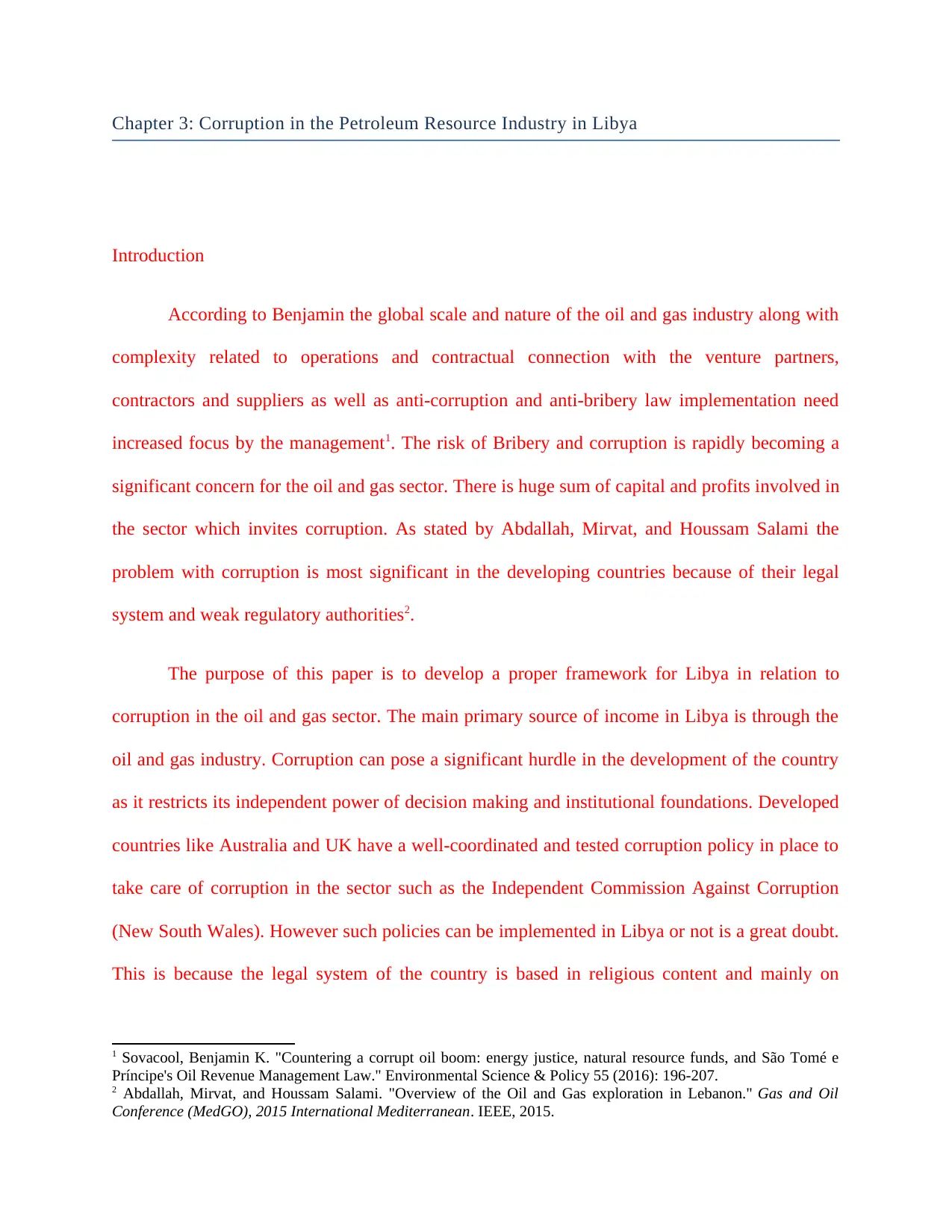
Chapter 3: Corruption in the Petroleum Resource Industry in Libya
Introduction
According to Benjamin the global scale and nature of the oil and gas industry along with
complexity related to operations and contractual connection with the venture partners,
contractors and suppliers as well as anti-corruption and anti-bribery law implementation need
increased focus by the management1. The risk of Bribery and corruption is rapidly becoming a
significant concern for the oil and gas sector. There is huge sum of capital and profits involved in
the sector which invites corruption. As stated by Abdallah, Mirvat, and Houssam Salami the
problem with corruption is most significant in the developing countries because of their legal
system and weak regulatory authorities2.
The purpose of this paper is to develop a proper framework for Libya in relation to
corruption in the oil and gas sector. The main primary source of income in Libya is through the
oil and gas industry. Corruption can pose a significant hurdle in the development of the country
as it restricts its independent power of decision making and institutional foundations. Developed
countries like Australia and UK have a well-coordinated and tested corruption policy in place to
take care of corruption in the sector such as the Independent Commission Against Corruption
(New South Wales). However such policies can be implemented in Libya or not is a great doubt.
This is because the legal system of the country is based in religious content and mainly on
1 Sovacool, Benjamin K. "Countering a corrupt oil boom: energy justice, natural resource funds, and São Tomé e
Príncipe's Oil Revenue Management Law." Environmental Science & Policy 55 (2016): 196-207.
2 Abdallah, Mirvat, and Houssam Salami. "Overview of the Oil and Gas exploration in Lebanon." Gas and Oil
Conference (MedGO), 2015 International Mediterranean. IEEE, 2015.
Introduction
According to Benjamin the global scale and nature of the oil and gas industry along with
complexity related to operations and contractual connection with the venture partners,
contractors and suppliers as well as anti-corruption and anti-bribery law implementation need
increased focus by the management1. The risk of Bribery and corruption is rapidly becoming a
significant concern for the oil and gas sector. There is huge sum of capital and profits involved in
the sector which invites corruption. As stated by Abdallah, Mirvat, and Houssam Salami the
problem with corruption is most significant in the developing countries because of their legal
system and weak regulatory authorities2.
The purpose of this paper is to develop a proper framework for Libya in relation to
corruption in the oil and gas sector. The main primary source of income in Libya is through the
oil and gas industry. Corruption can pose a significant hurdle in the development of the country
as it restricts its independent power of decision making and institutional foundations. Developed
countries like Australia and UK have a well-coordinated and tested corruption policy in place to
take care of corruption in the sector such as the Independent Commission Against Corruption
(New South Wales). However such policies can be implemented in Libya or not is a great doubt.
This is because the legal system of the country is based in religious content and mainly on
1 Sovacool, Benjamin K. "Countering a corrupt oil boom: energy justice, natural resource funds, and São Tomé e
Príncipe's Oil Revenue Management Law." Environmental Science & Policy 55 (2016): 196-207.
2 Abdallah, Mirvat, and Houssam Salami. "Overview of the Oil and Gas exploration in Lebanon." Gas and Oil
Conference (MedGO), 2015 International Mediterranean. IEEE, 2015.
Paraphrase This Document
Need a fresh take? Get an instant paraphrase of this document with our AI Paraphraser
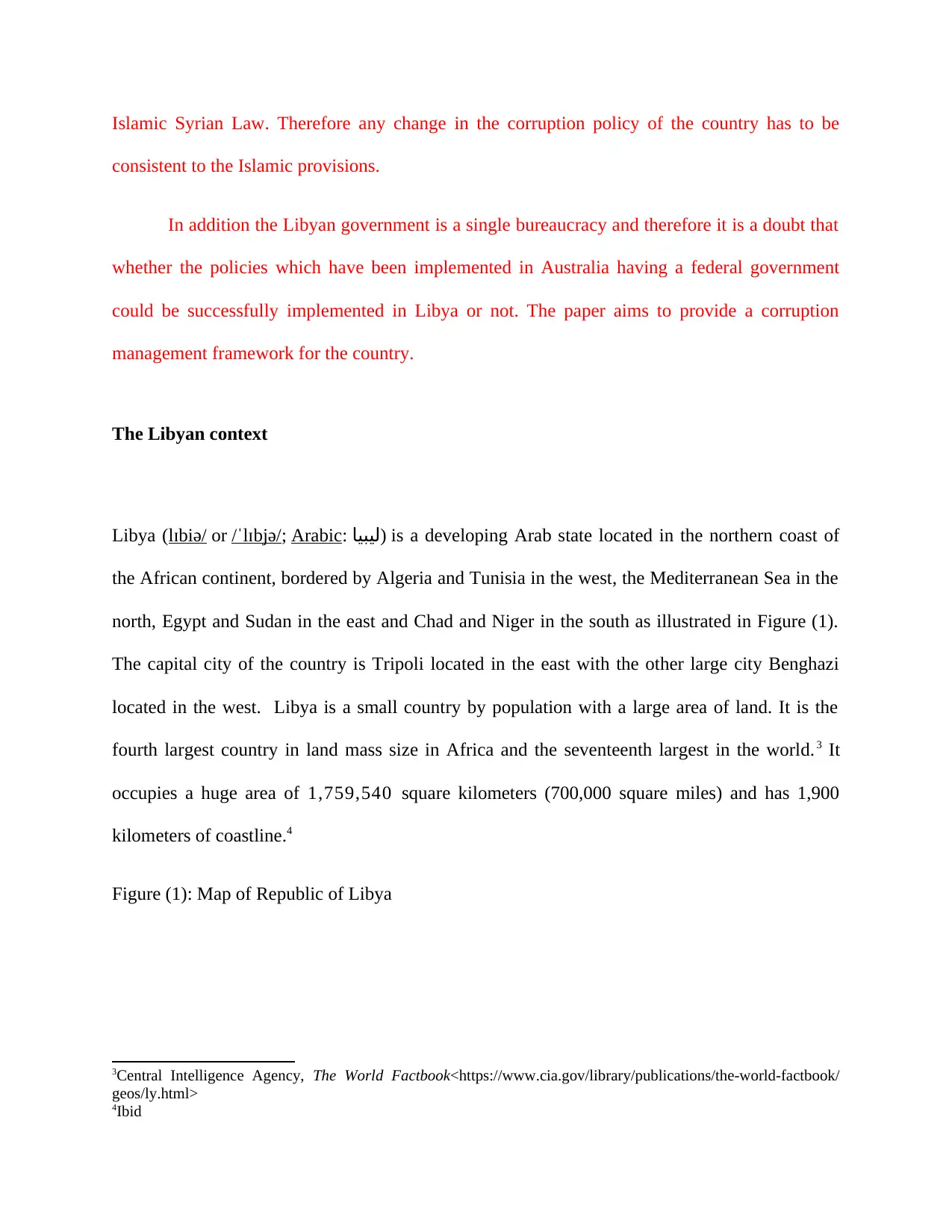
Islamic Syrian Law. Therefore any change in the corruption policy of the country has to be
consistent to the Islamic provisions.
In addition the Libyan government is a single bureaucracy and therefore it is a doubt that
whether the policies which have been implemented in Australia having a federal government
could be successfully implemented in Libya or not. The paper aims to provide a corruption
management framework for the country.
The Libyan context
Libya (lɪbiə/ or /ˈlɪbjə/; Arabic: ليبيا) is a developing Arab state located in the northern coast of
the African continent, bordered by Algeria and Tunisia in the west, the Mediterranean Sea in the
north, Egypt and Sudan in the east and Chad and Niger in the south as illustrated in Figure (1).
The capital city of the country is Tripoli located in the east with the other large city Benghazi
located in the west. Libya is a small country by population with a large area of land. It is the
fourth largest country in land mass size in Africa and the seventeenth largest in the world.3 It
occupies a huge area of 1,759,540 square kilometers (700,000 square miles) and has 1,900
kilometers of coastline.4
Figure (1): Map of Republic of Libya
3Central Intelligence Agency, The World Factbook<https://www.cia.gov/library/publications/the-world-factbook/
geos/ly.html>
4Ibid
consistent to the Islamic provisions.
In addition the Libyan government is a single bureaucracy and therefore it is a doubt that
whether the policies which have been implemented in Australia having a federal government
could be successfully implemented in Libya or not. The paper aims to provide a corruption
management framework for the country.
The Libyan context
Libya (lɪbiə/ or /ˈlɪbjə/; Arabic: ليبيا) is a developing Arab state located in the northern coast of
the African continent, bordered by Algeria and Tunisia in the west, the Mediterranean Sea in the
north, Egypt and Sudan in the east and Chad and Niger in the south as illustrated in Figure (1).
The capital city of the country is Tripoli located in the east with the other large city Benghazi
located in the west. Libya is a small country by population with a large area of land. It is the
fourth largest country in land mass size in Africa and the seventeenth largest in the world.3 It
occupies a huge area of 1,759,540 square kilometers (700,000 square miles) and has 1,900
kilometers of coastline.4
Figure (1): Map of Republic of Libya
3Central Intelligence Agency, The World Factbook<https://www.cia.gov/library/publications/the-world-factbook/
geos/ly.html>
4Ibid
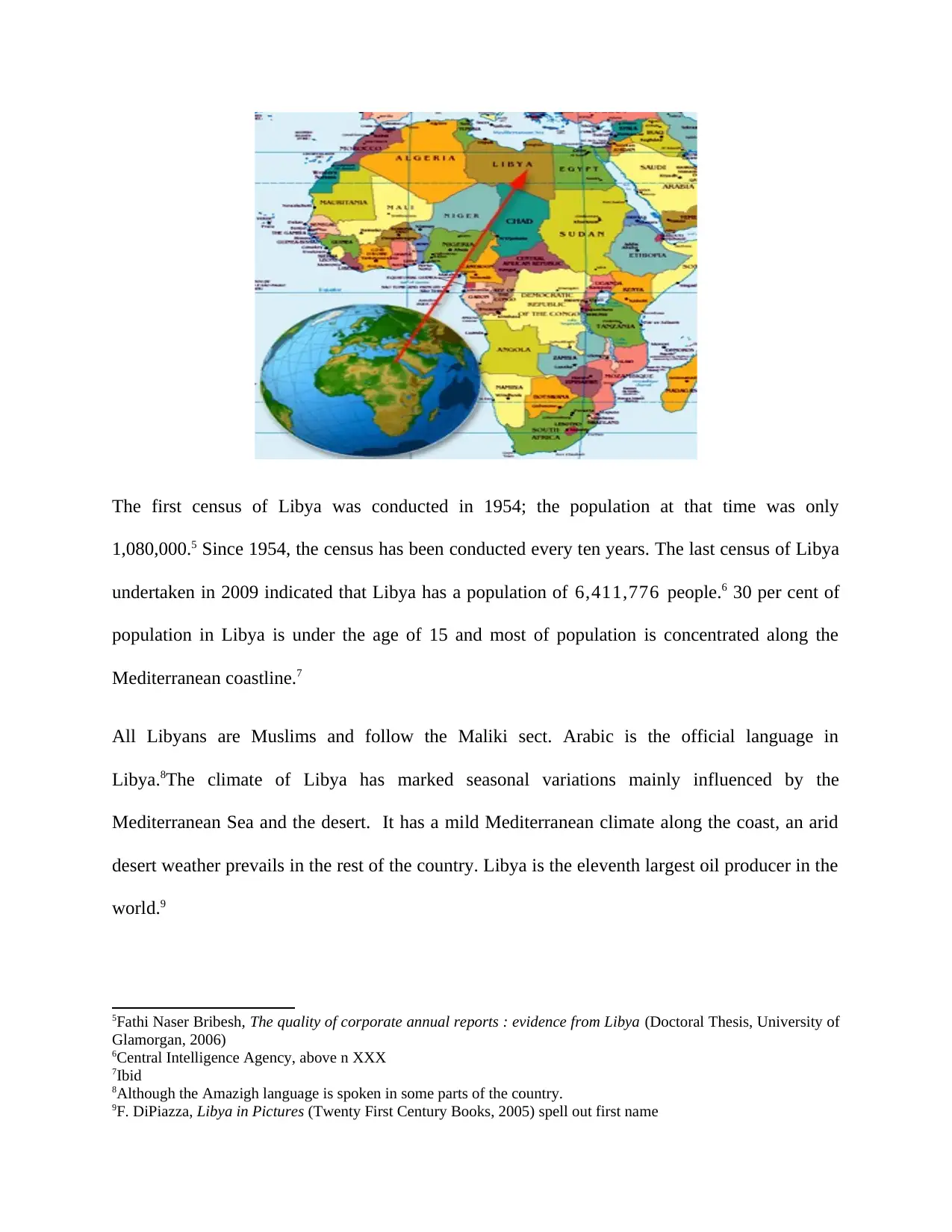
The first census of Libya was conducted in 1954; the population at that time was only
1,080,000.5 Since 1954, the census has been conducted every ten years. The last census of Libya
undertaken in 2009 indicated that Libya has a population of 6,411,776 people.6 30 per cent of
population in Libya is under the age of 15 and most of population is concentrated along the
Mediterranean coastline.7
All Libyans are Muslims and follow the Maliki sect. Arabic is the official language in
Libya.8The climate of Libya has marked seasonal variations mainly influenced by the
Mediterranean Sea and the desert. It has a mild Mediterranean climate along the coast, an arid
desert weather prevails in the rest of the country. Libya is the eleventh largest oil producer in the
world.9
5Fathi Naser Bribesh, The quality of corporate annual reports : evidence from Libya (Doctoral Thesis, University of
Glamorgan, 2006)
6Central Intelligence Agency, above n XXX
7Ibid
8Although the Amazigh language is spoken in some parts of the country.
9F. DiPiazza, Libya in Pictures (Twenty First Century Books, 2005) spell out first name
1,080,000.5 Since 1954, the census has been conducted every ten years. The last census of Libya
undertaken in 2009 indicated that Libya has a population of 6,411,776 people.6 30 per cent of
population in Libya is under the age of 15 and most of population is concentrated along the
Mediterranean coastline.7
All Libyans are Muslims and follow the Maliki sect. Arabic is the official language in
Libya.8The climate of Libya has marked seasonal variations mainly influenced by the
Mediterranean Sea and the desert. It has a mild Mediterranean climate along the coast, an arid
desert weather prevails in the rest of the country. Libya is the eleventh largest oil producer in the
world.9
5Fathi Naser Bribesh, The quality of corporate annual reports : evidence from Libya (Doctoral Thesis, University of
Glamorgan, 2006)
6Central Intelligence Agency, above n XXX
7Ibid
8Although the Amazigh language is spoken in some parts of the country.
9F. DiPiazza, Libya in Pictures (Twenty First Century Books, 2005) spell out first name
⊘ This is a preview!⊘
Do you want full access?
Subscribe today to unlock all pages.

Trusted by 1+ million students worldwide
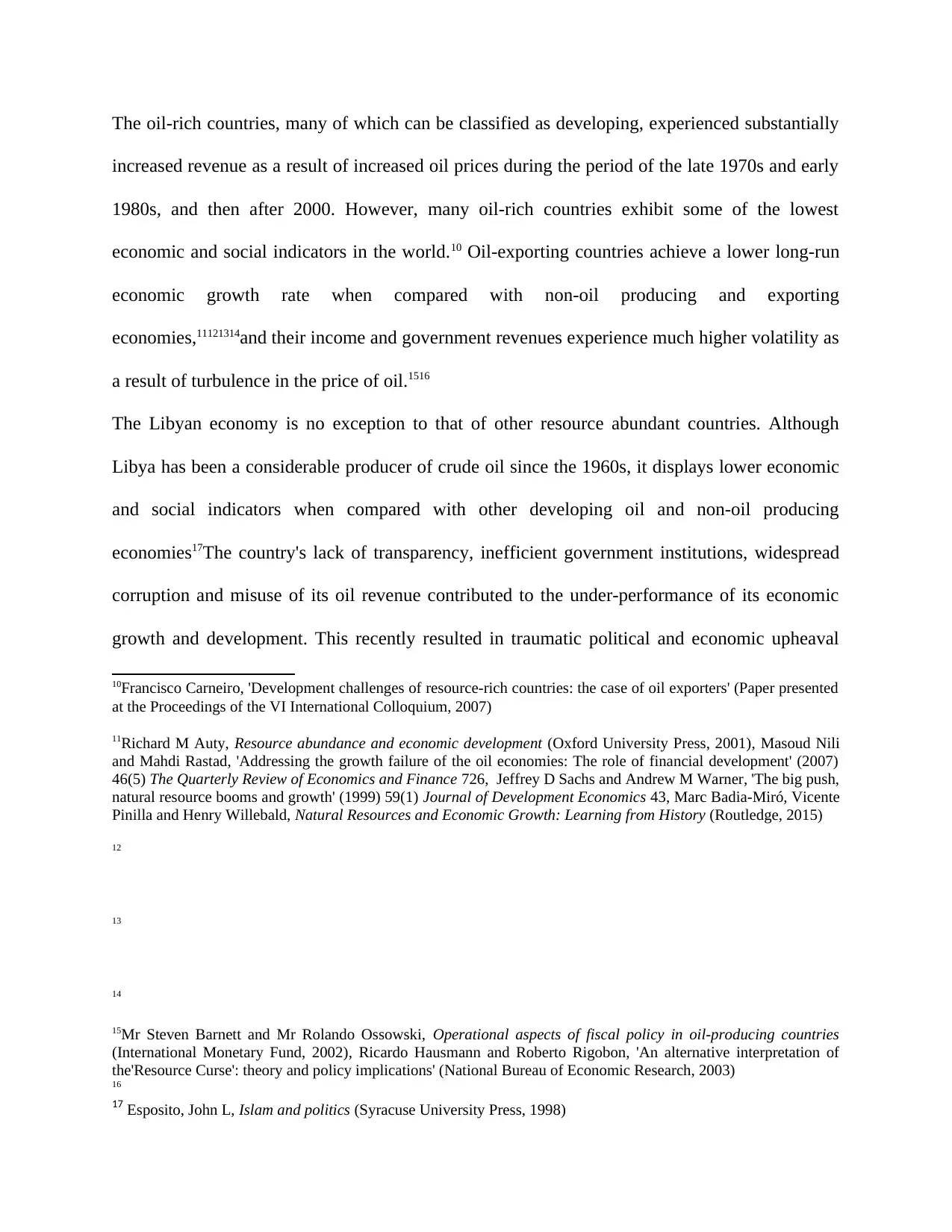
The oil-rich countries, many of which can be classified as developing, experienced substantially
increased revenue as a result of increased oil prices during the period of the late 1970s and early
1980s, and then after 2000. However, many oil-rich countries exhibit some of the lowest
economic and social indicators in the world.10 Oil-exporting countries achieve a lower long-run
economic growth rate when compared with non-oil producing and exporting
economies,11121314and their income and government revenues experience much higher volatility as
a result of turbulence in the price of oil.1516
The Libyan economy is no exception to that of other resource abundant countries. Although
Libya has been a considerable producer of crude oil since the 1960s, it displays lower economic
and social indicators when compared with other developing oil and non-oil producing
economies17The country's lack of transparency, inefficient government institutions, widespread
corruption and misuse of its oil revenue contributed to the under-performance of its economic
growth and development. This recently resulted in traumatic political and economic upheaval
10Francisco Carneiro, 'Development challenges of resource-rich countries: the case of oil exporters' (Paper presented
at the Proceedings of the VI International Colloquium, 2007)
11Richard M Auty, Resource abundance and economic development (Oxford University Press, 2001), Masoud Nili
and Mahdi Rastad, 'Addressing the growth failure of the oil economies: The role of financial development' (2007)
46(5) The Quarterly Review of Economics and Finance 726, Jeffrey D Sachs and Andrew M Warner, 'The big push,
natural resource booms and growth' (1999) 59(1) Journal of Development Economics 43, Marc Badia-Miró, Vicente
Pinilla and Henry Willebald, Natural Resources and Economic Growth: Learning from History (Routledge, 2015)
12
13
14
15Mr Steven Barnett and Mr Rolando Ossowski, Operational aspects of fiscal policy in oil-producing countries
(International Monetary Fund, 2002), Ricardo Hausmann and Roberto Rigobon, 'An alternative interpretation of
the'Resource Curse': theory and policy implications' (National Bureau of Economic Research, 2003)
16
17 Esposito, John L, Islam and politics (Syracuse University Press, 1998)
increased revenue as a result of increased oil prices during the period of the late 1970s and early
1980s, and then after 2000. However, many oil-rich countries exhibit some of the lowest
economic and social indicators in the world.10 Oil-exporting countries achieve a lower long-run
economic growth rate when compared with non-oil producing and exporting
economies,11121314and their income and government revenues experience much higher volatility as
a result of turbulence in the price of oil.1516
The Libyan economy is no exception to that of other resource abundant countries. Although
Libya has been a considerable producer of crude oil since the 1960s, it displays lower economic
and social indicators when compared with other developing oil and non-oil producing
economies17The country's lack of transparency, inefficient government institutions, widespread
corruption and misuse of its oil revenue contributed to the under-performance of its economic
growth and development. This recently resulted in traumatic political and economic upheaval
10Francisco Carneiro, 'Development challenges of resource-rich countries: the case of oil exporters' (Paper presented
at the Proceedings of the VI International Colloquium, 2007)
11Richard M Auty, Resource abundance and economic development (Oxford University Press, 2001), Masoud Nili
and Mahdi Rastad, 'Addressing the growth failure of the oil economies: The role of financial development' (2007)
46(5) The Quarterly Review of Economics and Finance 726, Jeffrey D Sachs and Andrew M Warner, 'The big push,
natural resource booms and growth' (1999) 59(1) Journal of Development Economics 43, Marc Badia-Miró, Vicente
Pinilla and Henry Willebald, Natural Resources and Economic Growth: Learning from History (Routledge, 2015)
12
13
14
15Mr Steven Barnett and Mr Rolando Ossowski, Operational aspects of fiscal policy in oil-producing countries
(International Monetary Fund, 2002), Ricardo Hausmann and Roberto Rigobon, 'An alternative interpretation of
the'Resource Curse': theory and policy implications' (National Bureau of Economic Research, 2003)
16
17 Esposito, John L, Islam and politics (Syracuse University Press, 1998)
Paraphrase This Document
Need a fresh take? Get an instant paraphrase of this document with our AI Paraphraser
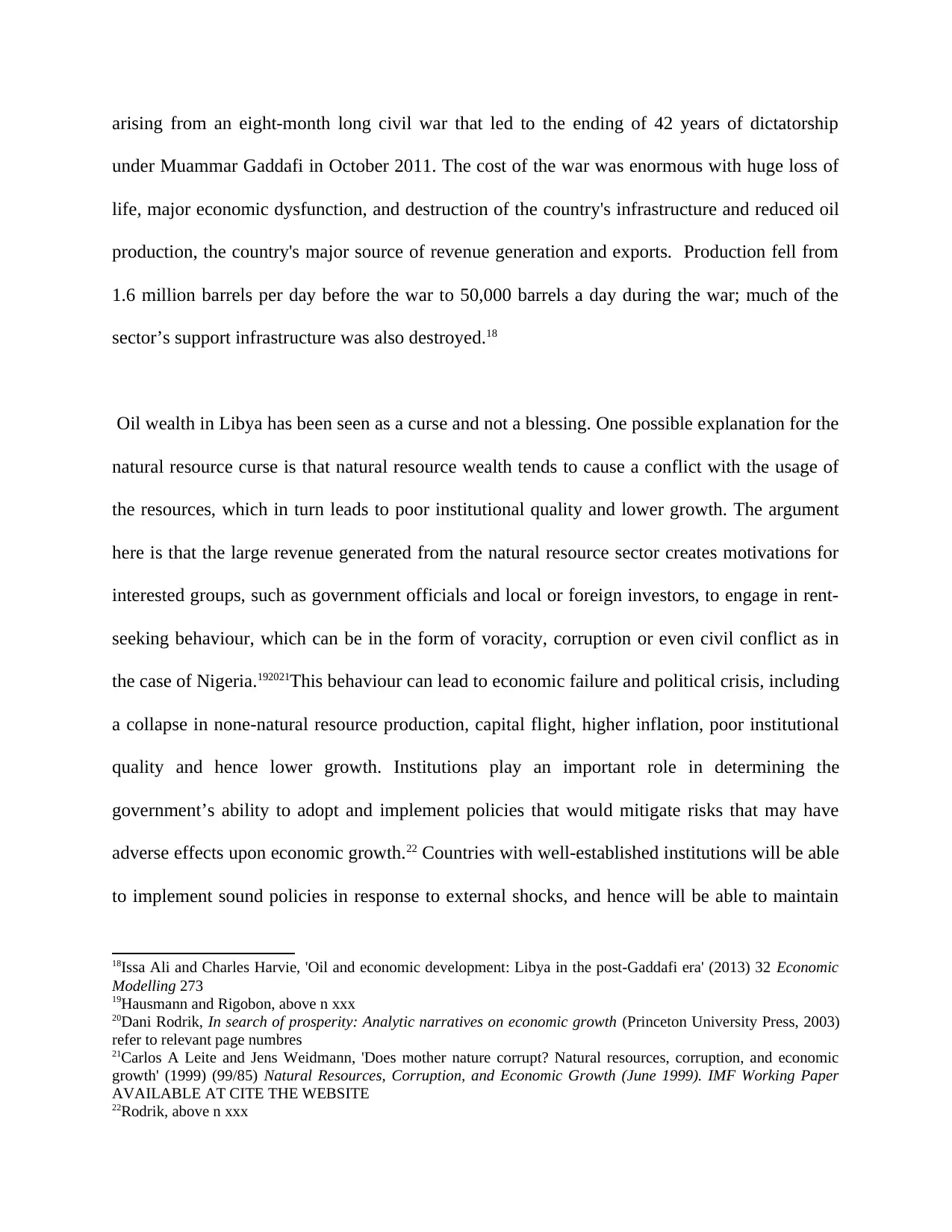
arising from an eight-month long civil war that led to the ending of 42 years of dictatorship
under Muammar Gaddafi in October 2011. The cost of the war was enormous with huge loss of
life, major economic dysfunction, and destruction of the country's infrastructure and reduced oil
production, the country's major source of revenue generation and exports. Production fell from
1.6 million barrels per day before the war to 50,000 barrels a day during the war; much of the
sector’s support infrastructure was also destroyed.18
Oil wealth in Libya has been seen as a curse and not a blessing. One possible explanation for the
natural resource curse is that natural resource wealth tends to cause a conflict with the usage of
the resources, which in turn leads to poor institutional quality and lower growth. The argument
here is that the large revenue generated from the natural resource sector creates motivations for
interested groups, such as government officials and local or foreign investors, to engage in rent-
seeking behaviour, which can be in the form of voracity, corruption or even civil conflict as in
the case of Nigeria.192021This behaviour can lead to economic failure and political crisis, including
a collapse in none-natural resource production, capital flight, higher inflation, poor institutional
quality and hence lower growth. Institutions play an important role in determining the
government’s ability to adopt and implement policies that would mitigate risks that may have
adverse effects upon economic growth.22 Countries with well-established institutions will be able
to implement sound policies in response to external shocks, and hence will be able to maintain
18Issa Ali and Charles Harvie, 'Oil and economic development: Libya in the post-Gaddafi era' (2013) 32 Economic
Modelling 273
19Hausmann and Rigobon, above n xxx
20Dani Rodrik, In search of prosperity: Analytic narratives on economic growth (Princeton University Press, 2003)
refer to relevant page numbres
21Carlos A Leite and Jens Weidmann, 'Does mother nature corrupt? Natural resources, corruption, and economic
growth' (1999) (99/85) Natural Resources, Corruption, and Economic Growth (June 1999). IMF Working Paper
AVAILABLE AT CITE THE WEBSITE
22Rodrik, above n xxx
under Muammar Gaddafi in October 2011. The cost of the war was enormous with huge loss of
life, major economic dysfunction, and destruction of the country's infrastructure and reduced oil
production, the country's major source of revenue generation and exports. Production fell from
1.6 million barrels per day before the war to 50,000 barrels a day during the war; much of the
sector’s support infrastructure was also destroyed.18
Oil wealth in Libya has been seen as a curse and not a blessing. One possible explanation for the
natural resource curse is that natural resource wealth tends to cause a conflict with the usage of
the resources, which in turn leads to poor institutional quality and lower growth. The argument
here is that the large revenue generated from the natural resource sector creates motivations for
interested groups, such as government officials and local or foreign investors, to engage in rent-
seeking behaviour, which can be in the form of voracity, corruption or even civil conflict as in
the case of Nigeria.192021This behaviour can lead to economic failure and political crisis, including
a collapse in none-natural resource production, capital flight, higher inflation, poor institutional
quality and hence lower growth. Institutions play an important role in determining the
government’s ability to adopt and implement policies that would mitigate risks that may have
adverse effects upon economic growth.22 Countries with well-established institutions will be able
to implement sound policies in response to external shocks, and hence will be able to maintain
18Issa Ali and Charles Harvie, 'Oil and economic development: Libya in the post-Gaddafi era' (2013) 32 Economic
Modelling 273
19Hausmann and Rigobon, above n xxx
20Dani Rodrik, In search of prosperity: Analytic narratives on economic growth (Princeton University Press, 2003)
refer to relevant page numbres
21Carlos A Leite and Jens Weidmann, 'Does mother nature corrupt? Natural resources, corruption, and economic
growth' (1999) (99/85) Natural Resources, Corruption, and Economic Growth (June 1999). IMF Working Paper
AVAILABLE AT CITE THE WEBSITE
22Rodrik, above n xxx
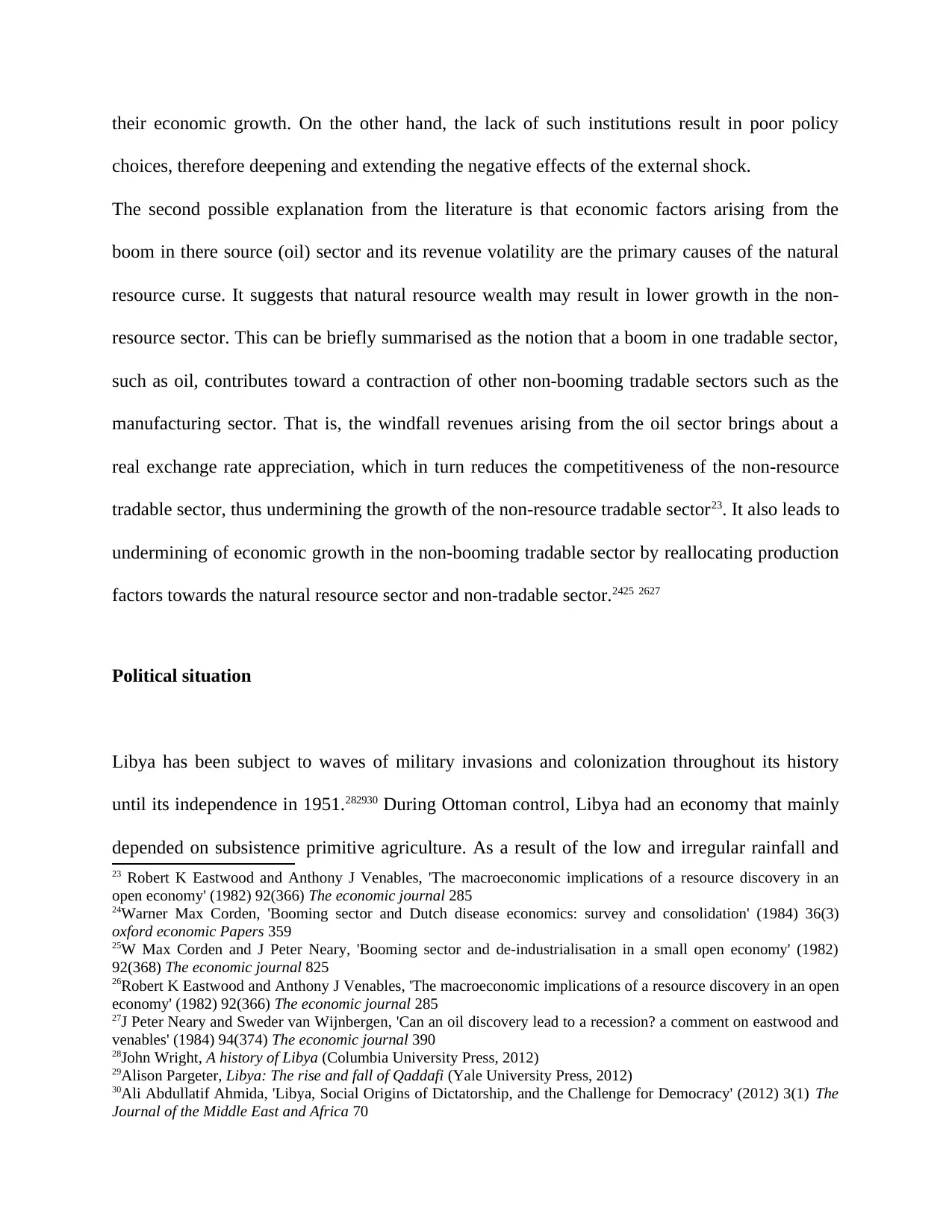
their economic growth. On the other hand, the lack of such institutions result in poor policy
choices, therefore deepening and extending the negative effects of the external shock.
The second possible explanation from the literature is that economic factors arising from the
boom in there source (oil) sector and its revenue volatility are the primary causes of the natural
resource curse. It suggests that natural resource wealth may result in lower growth in the non-
resource sector. This can be briefly summarised as the notion that a boom in one tradable sector,
such as oil, contributes toward a contraction of other non-booming tradable sectors such as the
manufacturing sector. That is, the windfall revenues arising from the oil sector brings about a
real exchange rate appreciation, which in turn reduces the competitiveness of the non-resource
tradable sector, thus undermining the growth of the non-resource tradable sector23. It also leads to
undermining of economic growth in the non-booming tradable sector by reallocating production
factors towards the natural resource sector and non-tradable sector.2425 2627
Political situation
Libya has been subject to waves of military invasions and colonization throughout its history
until its independence in 1951.282930 During Ottoman control, Libya had an economy that mainly
depended on subsistence primitive agriculture. As a result of the low and irregular rainfall and
23 Robert K Eastwood and Anthony J Venables, 'The macroeconomic implications of a resource discovery in an
open economy' (1982) 92(366) The economic journal 285
24Warner Max Corden, 'Booming sector and Dutch disease economics: survey and consolidation' (1984) 36(3)
oxford economic Papers 359
25W Max Corden and J Peter Neary, 'Booming sector and de-industrialisation in a small open economy' (1982)
92(368) The economic journal 825
26Robert K Eastwood and Anthony J Venables, 'The macroeconomic implications of a resource discovery in an open
economy' (1982) 92(366) The economic journal 285
27J Peter Neary and Sweder van Wijnbergen, 'Can an oil discovery lead to a recession? a comment on eastwood and
venables' (1984) 94(374) The economic journal 390
28John Wright, A history of Libya (Columbia University Press, 2012)
29Alison Pargeter, Libya: The rise and fall of Qaddafi (Yale University Press, 2012)
30Ali Abdullatif Ahmida, 'Libya, Social Origins of Dictatorship, and the Challenge for Democracy' (2012) 3(1) The
Journal of the Middle East and Africa 70
choices, therefore deepening and extending the negative effects of the external shock.
The second possible explanation from the literature is that economic factors arising from the
boom in there source (oil) sector and its revenue volatility are the primary causes of the natural
resource curse. It suggests that natural resource wealth may result in lower growth in the non-
resource sector. This can be briefly summarised as the notion that a boom in one tradable sector,
such as oil, contributes toward a contraction of other non-booming tradable sectors such as the
manufacturing sector. That is, the windfall revenues arising from the oil sector brings about a
real exchange rate appreciation, which in turn reduces the competitiveness of the non-resource
tradable sector, thus undermining the growth of the non-resource tradable sector23. It also leads to
undermining of economic growth in the non-booming tradable sector by reallocating production
factors towards the natural resource sector and non-tradable sector.2425 2627
Political situation
Libya has been subject to waves of military invasions and colonization throughout its history
until its independence in 1951.282930 During Ottoman control, Libya had an economy that mainly
depended on subsistence primitive agriculture. As a result of the low and irregular rainfall and
23 Robert K Eastwood and Anthony J Venables, 'The macroeconomic implications of a resource discovery in an
open economy' (1982) 92(366) The economic journal 285
24Warner Max Corden, 'Booming sector and Dutch disease economics: survey and consolidation' (1984) 36(3)
oxford economic Papers 359
25W Max Corden and J Peter Neary, 'Booming sector and de-industrialisation in a small open economy' (1982)
92(368) The economic journal 825
26Robert K Eastwood and Anthony J Venables, 'The macroeconomic implications of a resource discovery in an open
economy' (1982) 92(366) The economic journal 285
27J Peter Neary and Sweder van Wijnbergen, 'Can an oil discovery lead to a recession? a comment on eastwood and
venables' (1984) 94(374) The economic journal 390
28John Wright, A history of Libya (Columbia University Press, 2012)
29Alison Pargeter, Libya: The rise and fall of Qaddafi (Yale University Press, 2012)
30Ali Abdullatif Ahmida, 'Libya, Social Origins of Dictatorship, and the Challenge for Democracy' (2012) 3(1) The
Journal of the Middle East and Africa 70
⊘ This is a preview!⊘
Do you want full access?
Subscribe today to unlock all pages.

Trusted by 1+ million students worldwide
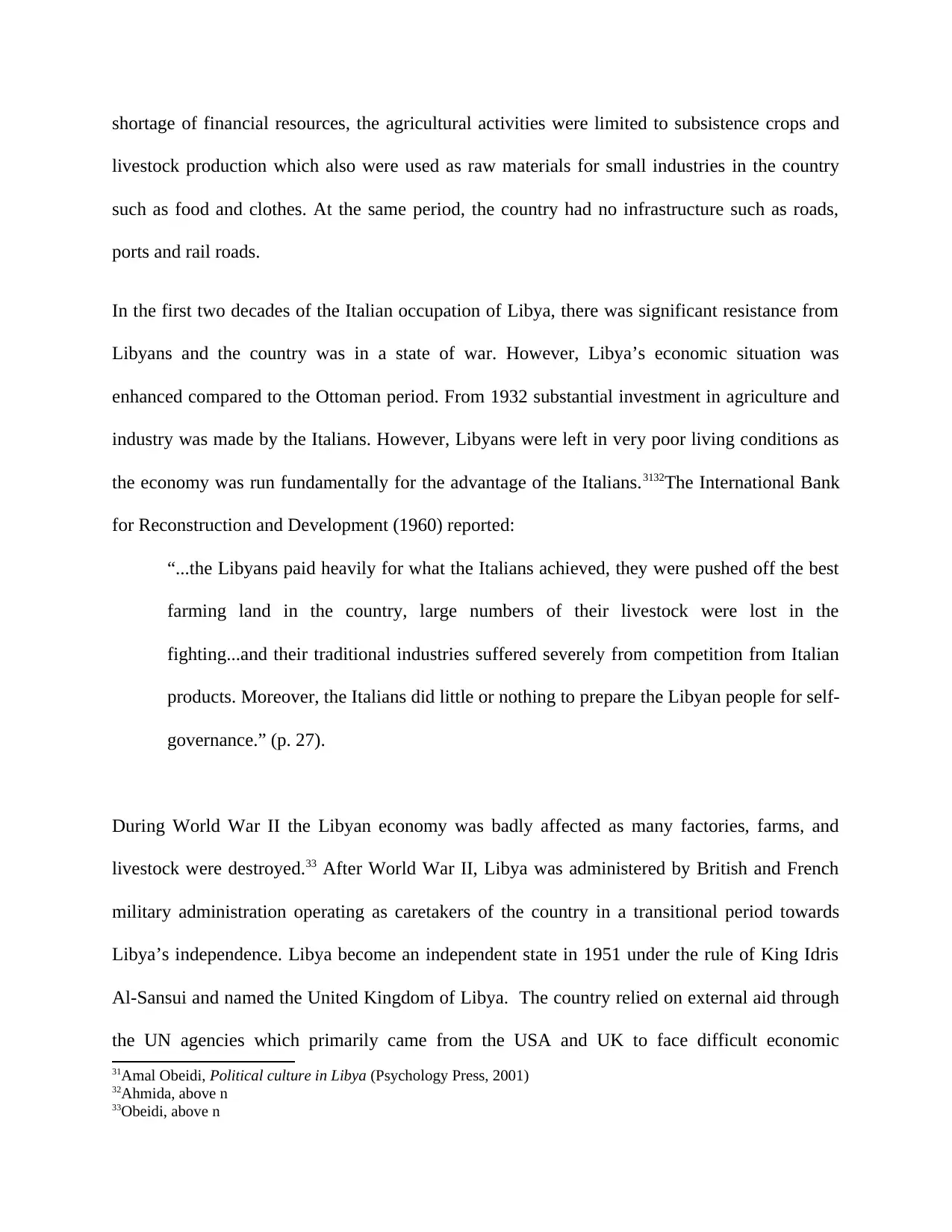
shortage of financial resources, the agricultural activities were limited to subsistence crops and
livestock production which also were used as raw materials for small industries in the country
such as food and clothes. At the same period, the country had no infrastructure such as roads,
ports and rail roads.
In the first two decades of the Italian occupation of Libya, there was significant resistance from
Libyans and the country was in a state of war. However, Libya’s economic situation was
enhanced compared to the Ottoman period. From 1932 substantial investment in agriculture and
industry was made by the Italians. However, Libyans were left in very poor living conditions as
the economy was run fundamentally for the advantage of the Italians.3132The International Bank
for Reconstruction and Development (1960) reported:
“...the Libyans paid heavily for what the Italians achieved, they were pushed off the best
farming land in the country, large numbers of their livestock were lost in the
fighting...and their traditional industries suffered severely from competition from Italian
products. Moreover, the Italians did little or nothing to prepare the Libyan people for self-
governance.” (p. 27).
During World War II the Libyan economy was badly affected as many factories, farms, and
livestock were destroyed.33 After World War II, Libya was administered by British and French
military administration operating as caretakers of the country in a transitional period towards
Libya’s independence. Libya become an independent state in 1951 under the rule of King Idris
Al-Sansui and named the United Kingdom of Libya. The country relied on external aid through
the UN agencies which primarily came from the USA and UK to face difficult economic
31Amal Obeidi, Political culture in Libya (Psychology Press, 2001)
32Ahmida, above n
33Obeidi, above n
livestock production which also were used as raw materials for small industries in the country
such as food and clothes. At the same period, the country had no infrastructure such as roads,
ports and rail roads.
In the first two decades of the Italian occupation of Libya, there was significant resistance from
Libyans and the country was in a state of war. However, Libya’s economic situation was
enhanced compared to the Ottoman period. From 1932 substantial investment in agriculture and
industry was made by the Italians. However, Libyans were left in very poor living conditions as
the economy was run fundamentally for the advantage of the Italians.3132The International Bank
for Reconstruction and Development (1960) reported:
“...the Libyans paid heavily for what the Italians achieved, they were pushed off the best
farming land in the country, large numbers of their livestock were lost in the
fighting...and their traditional industries suffered severely from competition from Italian
products. Moreover, the Italians did little or nothing to prepare the Libyan people for self-
governance.” (p. 27).
During World War II the Libyan economy was badly affected as many factories, farms, and
livestock were destroyed.33 After World War II, Libya was administered by British and French
military administration operating as caretakers of the country in a transitional period towards
Libya’s independence. Libya become an independent state in 1951 under the rule of King Idris
Al-Sansui and named the United Kingdom of Libya. The country relied on external aid through
the UN agencies which primarily came from the USA and UK to face difficult economic
31Amal Obeidi, Political culture in Libya (Psychology Press, 2001)
32Ahmida, above n
33Obeidi, above n
Paraphrase This Document
Need a fresh take? Get an instant paraphrase of this document with our AI Paraphraser
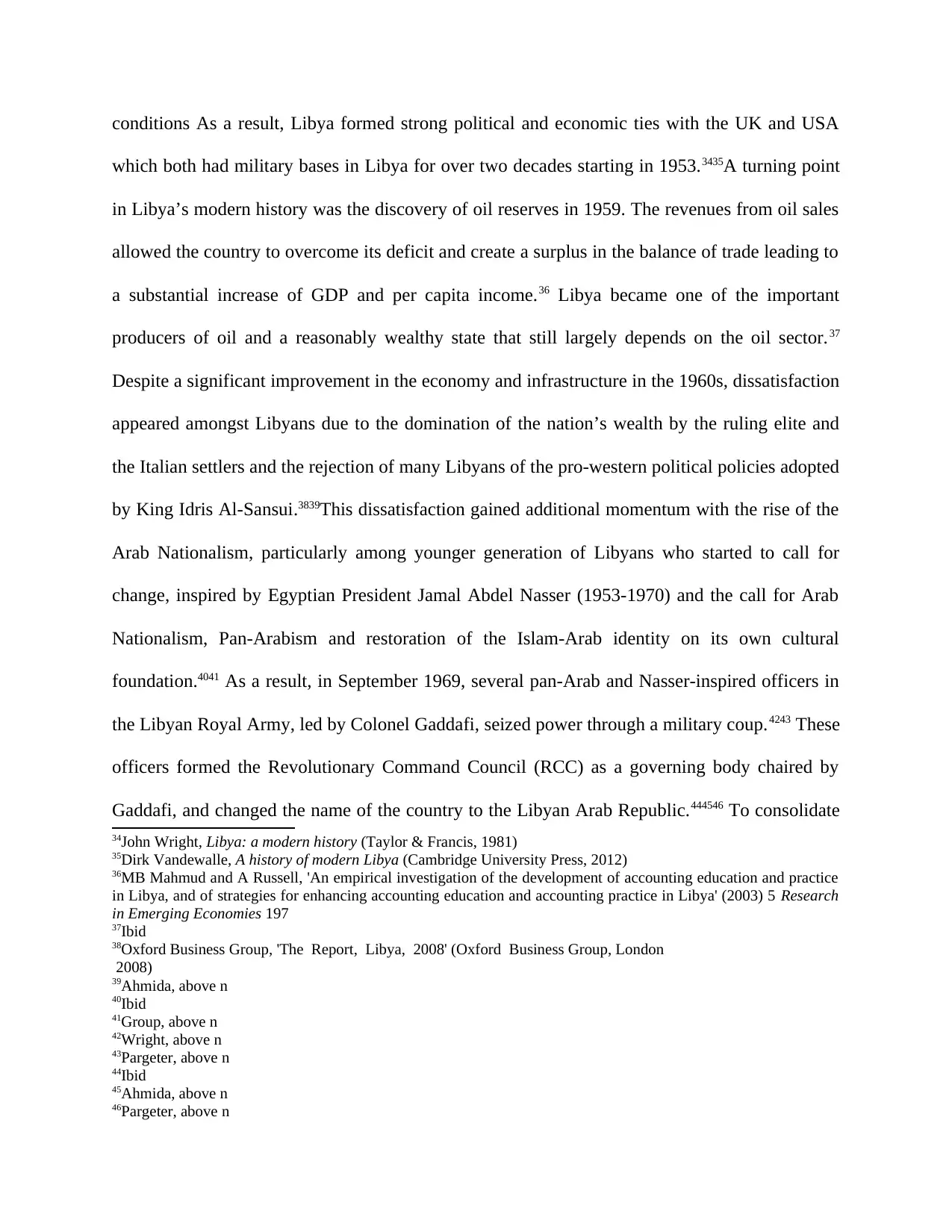
conditions As a result, Libya formed strong political and economic ties with the UK and USA
which both had military bases in Libya for over two decades starting in 1953.3435A turning point
in Libya’s modern history was the discovery of oil reserves in 1959. The revenues from oil sales
allowed the country to overcome its deficit and create a surplus in the balance of trade leading to
a substantial increase of GDP and per capita income.36 Libya became one of the important
producers of oil and a reasonably wealthy state that still largely depends on the oil sector.37
Despite a significant improvement in the economy and infrastructure in the 1960s, dissatisfaction
appeared amongst Libyans due to the domination of the nation’s wealth by the ruling elite and
the Italian settlers and the rejection of many Libyans of the pro-western political policies adopted
by King Idris Al-Sansui.3839This dissatisfaction gained additional momentum with the rise of the
Arab Nationalism, particularly among younger generation of Libyans who started to call for
change, inspired by Egyptian President Jamal Abdel Nasser (1953-1970) and the call for Arab
Nationalism, Pan-Arabism and restoration of the Islam-Arab identity on its own cultural
foundation.4041 As a result, in September 1969, several pan-Arab and Nasser-inspired officers in
the Libyan Royal Army, led by Colonel Gaddafi, seized power through a military coup.4243 These
officers formed the Revolutionary Command Council (RCC) as a governing body chaired by
Gaddafi, and changed the name of the country to the Libyan Arab Republic.444546 To consolidate
34John Wright, Libya: a modern history (Taylor & Francis, 1981)
35Dirk Vandewalle, A history of modern Libya (Cambridge University Press, 2012)
36MB Mahmud and A Russell, 'An empirical investigation of the development of accounting education and practice
in Libya, and of strategies for enhancing accounting education and accounting practice in Libya' (2003) 5 Research
in Emerging Economies 197
37Ibid
38Oxford Business Group, 'The Report, Libya, 2008' (Oxford Business Group, London
2008)
39Ahmida, above n
40Ibid
41Group, above n
42Wright, above n
43Pargeter, above n
44Ibid
45Ahmida, above n
46Pargeter, above n
which both had military bases in Libya for over two decades starting in 1953.3435A turning point
in Libya’s modern history was the discovery of oil reserves in 1959. The revenues from oil sales
allowed the country to overcome its deficit and create a surplus in the balance of trade leading to
a substantial increase of GDP and per capita income.36 Libya became one of the important
producers of oil and a reasonably wealthy state that still largely depends on the oil sector.37
Despite a significant improvement in the economy and infrastructure in the 1960s, dissatisfaction
appeared amongst Libyans due to the domination of the nation’s wealth by the ruling elite and
the Italian settlers and the rejection of many Libyans of the pro-western political policies adopted
by King Idris Al-Sansui.3839This dissatisfaction gained additional momentum with the rise of the
Arab Nationalism, particularly among younger generation of Libyans who started to call for
change, inspired by Egyptian President Jamal Abdel Nasser (1953-1970) and the call for Arab
Nationalism, Pan-Arabism and restoration of the Islam-Arab identity on its own cultural
foundation.4041 As a result, in September 1969, several pan-Arab and Nasser-inspired officers in
the Libyan Royal Army, led by Colonel Gaddafi, seized power through a military coup.4243 These
officers formed the Revolutionary Command Council (RCC) as a governing body chaired by
Gaddafi, and changed the name of the country to the Libyan Arab Republic.444546 To consolidate
34John Wright, Libya: a modern history (Taylor & Francis, 1981)
35Dirk Vandewalle, A history of modern Libya (Cambridge University Press, 2012)
36MB Mahmud and A Russell, 'An empirical investigation of the development of accounting education and practice
in Libya, and of strategies for enhancing accounting education and accounting practice in Libya' (2003) 5 Research
in Emerging Economies 197
37Ibid
38Oxford Business Group, 'The Report, Libya, 2008' (Oxford Business Group, London
2008)
39Ahmida, above n
40Ibid
41Group, above n
42Wright, above n
43Pargeter, above n
44Ibid
45Ahmida, above n
46Pargeter, above n
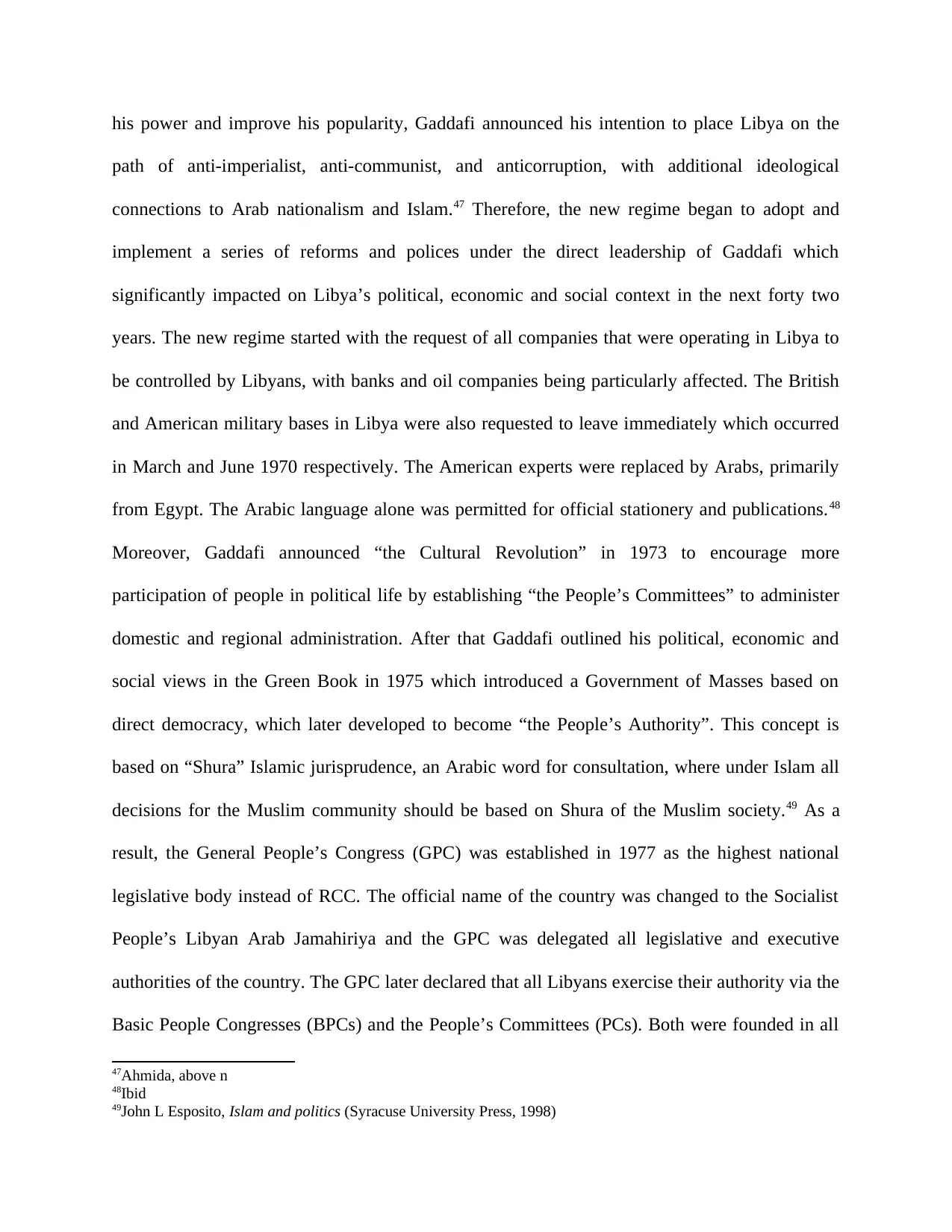
his power and improve his popularity, Gaddafi announced his intention to place Libya on the
path of anti-imperialist, anti-communist, and anticorruption, with additional ideological
connections to Arab nationalism and Islam.47 Therefore, the new regime began to adopt and
implement a series of reforms and polices under the direct leadership of Gaddafi which
significantly impacted on Libya’s political, economic and social context in the next forty two
years. The new regime started with the request of all companies that were operating in Libya to
be controlled by Libyans, with banks and oil companies being particularly affected. The British
and American military bases in Libya were also requested to leave immediately which occurred
in March and June 1970 respectively. The American experts were replaced by Arabs, primarily
from Egypt. The Arabic language alone was permitted for official stationery and publications.48
Moreover, Gaddafi announced “the Cultural Revolution” in 1973 to encourage more
participation of people in political life by establishing “the People’s Committees” to administer
domestic and regional administration. After that Gaddafi outlined his political, economic and
social views in the Green Book in 1975 which introduced a Government of Masses based on
direct democracy, which later developed to become “the People’s Authority”. This concept is
based on “Shura” Islamic jurisprudence, an Arabic word for consultation, where under Islam all
decisions for the Muslim community should be based on Shura of the Muslim society.49 As a
result, the General People’s Congress (GPC) was established in 1977 as the highest national
legislative body instead of RCC. The official name of the country was changed to the Socialist
People’s Libyan Arab Jamahiriya and the GPC was delegated all legislative and executive
authorities of the country. The GPC later declared that all Libyans exercise their authority via the
Basic People Congresses (BPCs) and the People’s Committees (PCs). Both were founded in all
47Ahmida, above n
48Ibid
49John L Esposito, Islam and politics (Syracuse University Press, 1998)
path of anti-imperialist, anti-communist, and anticorruption, with additional ideological
connections to Arab nationalism and Islam.47 Therefore, the new regime began to adopt and
implement a series of reforms and polices under the direct leadership of Gaddafi which
significantly impacted on Libya’s political, economic and social context in the next forty two
years. The new regime started with the request of all companies that were operating in Libya to
be controlled by Libyans, with banks and oil companies being particularly affected. The British
and American military bases in Libya were also requested to leave immediately which occurred
in March and June 1970 respectively. The American experts were replaced by Arabs, primarily
from Egypt. The Arabic language alone was permitted for official stationery and publications.48
Moreover, Gaddafi announced “the Cultural Revolution” in 1973 to encourage more
participation of people in political life by establishing “the People’s Committees” to administer
domestic and regional administration. After that Gaddafi outlined his political, economic and
social views in the Green Book in 1975 which introduced a Government of Masses based on
direct democracy, which later developed to become “the People’s Authority”. This concept is
based on “Shura” Islamic jurisprudence, an Arabic word for consultation, where under Islam all
decisions for the Muslim community should be based on Shura of the Muslim society.49 As a
result, the General People’s Congress (GPC) was established in 1977 as the highest national
legislative body instead of RCC. The official name of the country was changed to the Socialist
People’s Libyan Arab Jamahiriya and the GPC was delegated all legislative and executive
authorities of the country. The GPC later declared that all Libyans exercise their authority via the
Basic People Congresses (BPCs) and the People’s Committees (PCs). Both were founded in all
47Ahmida, above n
48Ibid
49John L Esposito, Islam and politics (Syracuse University Press, 1998)
⊘ This is a preview!⊘
Do you want full access?
Subscribe today to unlock all pages.

Trusted by 1+ million students worldwide
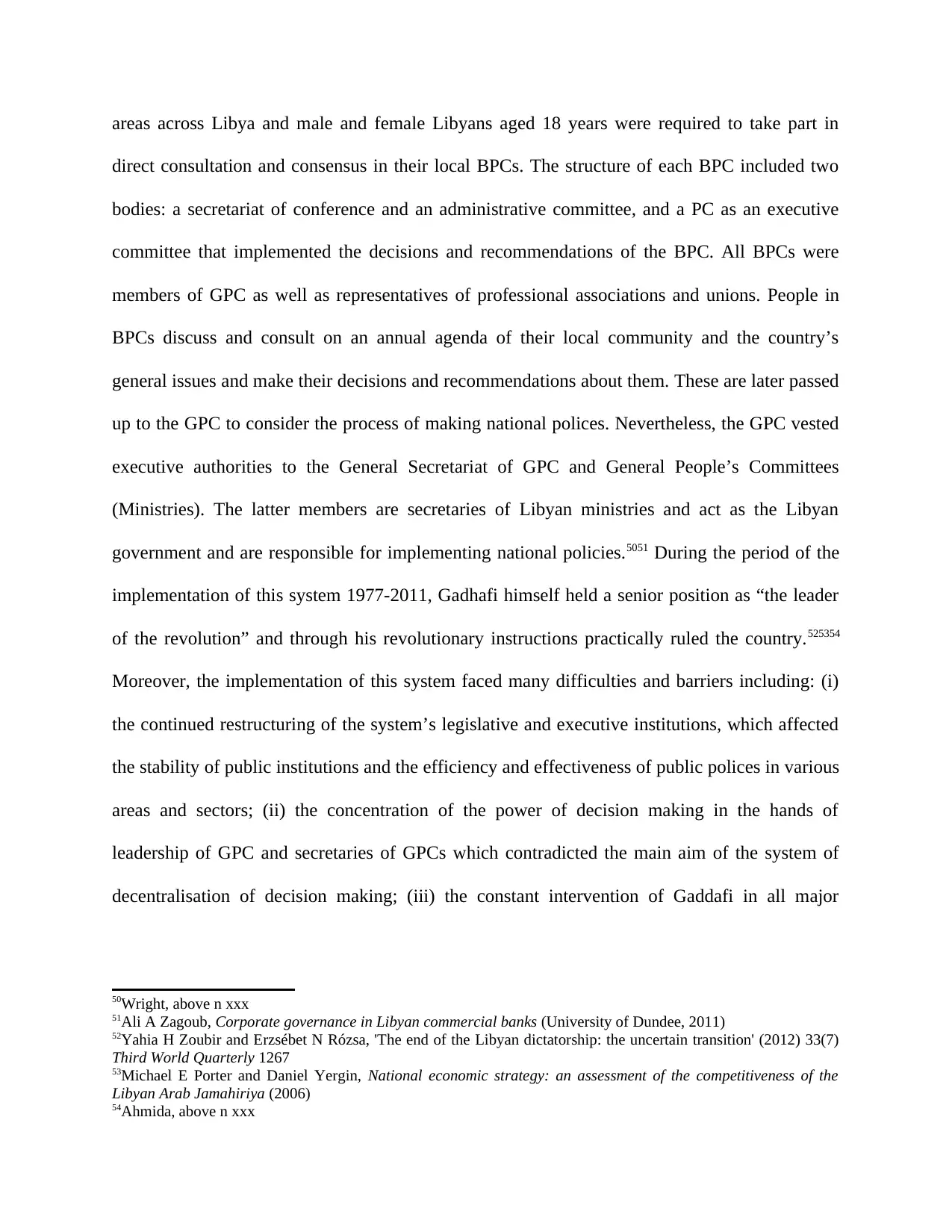
areas across Libya and male and female Libyans aged 18 years were required to take part in
direct consultation and consensus in their local BPCs. The structure of each BPC included two
bodies: a secretariat of conference and an administrative committee, and a PC as an executive
committee that implemented the decisions and recommendations of the BPC. All BPCs were
members of GPC as well as representatives of professional associations and unions. People in
BPCs discuss and consult on an annual agenda of their local community and the country’s
general issues and make their decisions and recommendations about them. These are later passed
up to the GPC to consider the process of making national polices. Nevertheless, the GPC vested
executive authorities to the General Secretariat of GPC and General People’s Committees
(Ministries). The latter members are secretaries of Libyan ministries and act as the Libyan
government and are responsible for implementing national policies.5051 During the period of the
implementation of this system 1977-2011, Gadhafi himself held a senior position as “the leader
of the revolution” and through his revolutionary instructions practically ruled the country.525354
Moreover, the implementation of this system faced many difficulties and barriers including: (i)
the continued restructuring of the system’s legislative and executive institutions, which affected
the stability of public institutions and the efficiency and effectiveness of public polices in various
areas and sectors; (ii) the concentration of the power of decision making in the hands of
leadership of GPC and secretaries of GPCs which contradicted the main aim of the system of
decentralisation of decision making; (iii) the constant intervention of Gaddafi in all major
50Wright, above n xxx
51Ali A Zagoub, Corporate governance in Libyan commercial banks (University of Dundee, 2011)
52Yahia H Zoubir and Erzsébet N Rózsa, 'The end of the Libyan dictatorship: the uncertain transition' (2012) 33(7)
Third World Quarterly 1267
53Michael E Porter and Daniel Yergin, National economic strategy: an assessment of the competitiveness of the
Libyan Arab Jamahiriya (2006)
54Ahmida, above n xxx
direct consultation and consensus in their local BPCs. The structure of each BPC included two
bodies: a secretariat of conference and an administrative committee, and a PC as an executive
committee that implemented the decisions and recommendations of the BPC. All BPCs were
members of GPC as well as representatives of professional associations and unions. People in
BPCs discuss and consult on an annual agenda of their local community and the country’s
general issues and make their decisions and recommendations about them. These are later passed
up to the GPC to consider the process of making national polices. Nevertheless, the GPC vested
executive authorities to the General Secretariat of GPC and General People’s Committees
(Ministries). The latter members are secretaries of Libyan ministries and act as the Libyan
government and are responsible for implementing national policies.5051 During the period of the
implementation of this system 1977-2011, Gadhafi himself held a senior position as “the leader
of the revolution” and through his revolutionary instructions practically ruled the country.525354
Moreover, the implementation of this system faced many difficulties and barriers including: (i)
the continued restructuring of the system’s legislative and executive institutions, which affected
the stability of public institutions and the efficiency and effectiveness of public polices in various
areas and sectors; (ii) the concentration of the power of decision making in the hands of
leadership of GPC and secretaries of GPCs which contradicted the main aim of the system of
decentralisation of decision making; (iii) the constant intervention of Gaddafi in all major
50Wright, above n xxx
51Ali A Zagoub, Corporate governance in Libyan commercial banks (University of Dundee, 2011)
52Yahia H Zoubir and Erzsébet N Rózsa, 'The end of the Libyan dictatorship: the uncertain transition' (2012) 33(7)
Third World Quarterly 1267
53Michael E Porter and Daniel Yergin, National economic strategy: an assessment of the competitiveness of the
Libyan Arab Jamahiriya (2006)
54Ahmida, above n xxx
Paraphrase This Document
Need a fresh take? Get an instant paraphrase of this document with our AI Paraphraser
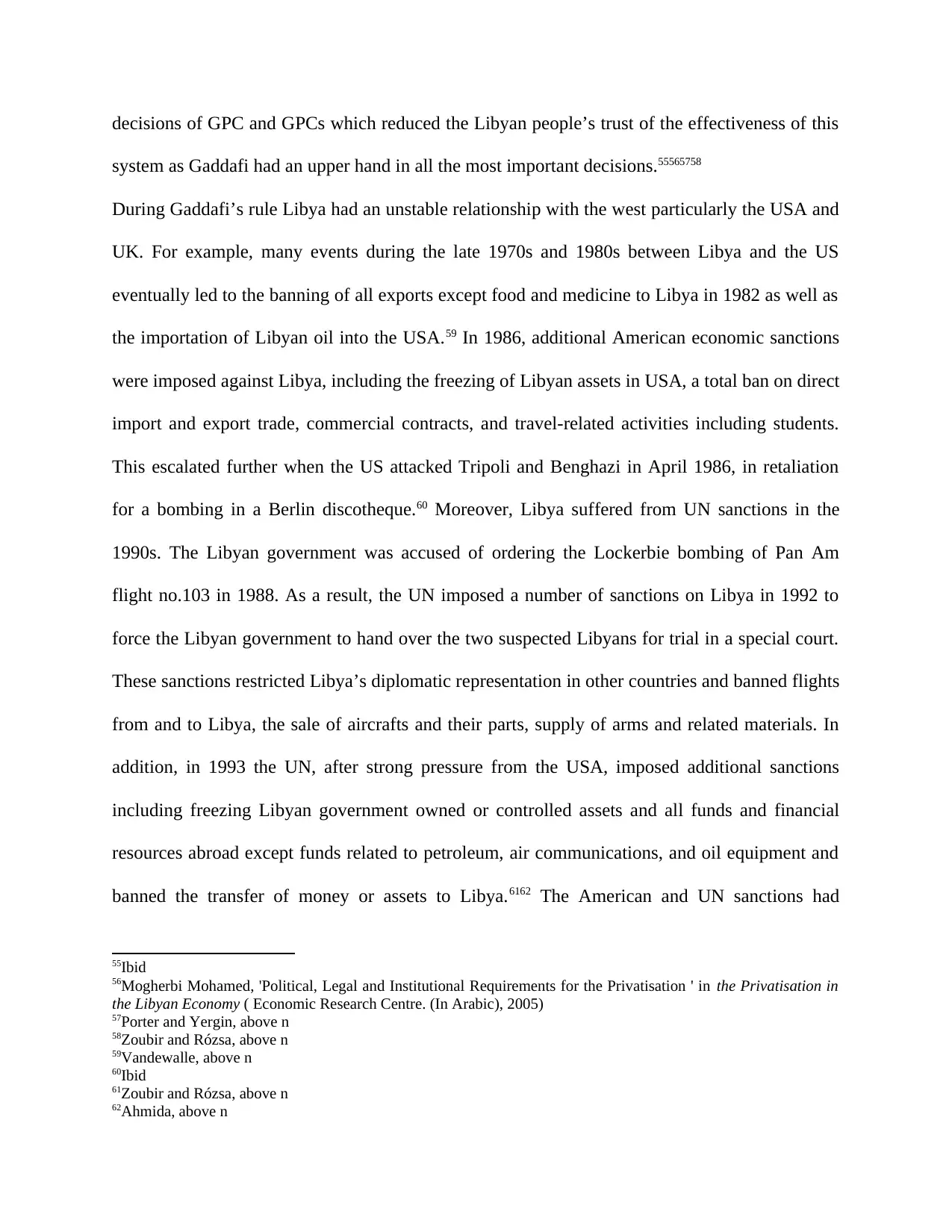
decisions of GPC and GPCs which reduced the Libyan people’s trust of the effectiveness of this
system as Gaddafi had an upper hand in all the most important decisions.55565758
During Gaddafi’s rule Libya had an unstable relationship with the west particularly the USA and
UK. For example, many events during the late 1970s and 1980s between Libya and the US
eventually led to the banning of all exports except food and medicine to Libya in 1982 as well as
the importation of Libyan oil into the USA.59 In 1986, additional American economic sanctions
were imposed against Libya, including the freezing of Libyan assets in USA, a total ban on direct
import and export trade, commercial contracts, and travel-related activities including students.
This escalated further when the US attacked Tripoli and Benghazi in April 1986, in retaliation
for a bombing in a Berlin discotheque.60 Moreover, Libya suffered from UN sanctions in the
1990s. The Libyan government was accused of ordering the Lockerbie bombing of Pan Am
flight no.103 in 1988. As a result, the UN imposed a number of sanctions on Libya in 1992 to
force the Libyan government to hand over the two suspected Libyans for trial in a special court.
These sanctions restricted Libya’s diplomatic representation in other countries and banned flights
from and to Libya, the sale of aircrafts and their parts, supply of arms and related materials. In
addition, in 1993 the UN, after strong pressure from the USA, imposed additional sanctions
including freezing Libyan government owned or controlled assets and all funds and financial
resources abroad except funds related to petroleum, air communications, and oil equipment and
banned the transfer of money or assets to Libya.6162 The American and UN sanctions had
55Ibid
56Mogherbi Mohamed, 'Political, Legal and Institutional Requirements for the Privatisation ' in the Privatisation in
the Libyan Economy ( Economic Research Centre. (In Arabic), 2005)
57Porter and Yergin, above n
58Zoubir and Rózsa, above n
59Vandewalle, above n
60Ibid
61Zoubir and Rózsa, above n
62Ahmida, above n
system as Gaddafi had an upper hand in all the most important decisions.55565758
During Gaddafi’s rule Libya had an unstable relationship with the west particularly the USA and
UK. For example, many events during the late 1970s and 1980s between Libya and the US
eventually led to the banning of all exports except food and medicine to Libya in 1982 as well as
the importation of Libyan oil into the USA.59 In 1986, additional American economic sanctions
were imposed against Libya, including the freezing of Libyan assets in USA, a total ban on direct
import and export trade, commercial contracts, and travel-related activities including students.
This escalated further when the US attacked Tripoli and Benghazi in April 1986, in retaliation
for a bombing in a Berlin discotheque.60 Moreover, Libya suffered from UN sanctions in the
1990s. The Libyan government was accused of ordering the Lockerbie bombing of Pan Am
flight no.103 in 1988. As a result, the UN imposed a number of sanctions on Libya in 1992 to
force the Libyan government to hand over the two suspected Libyans for trial in a special court.
These sanctions restricted Libya’s diplomatic representation in other countries and banned flights
from and to Libya, the sale of aircrafts and their parts, supply of arms and related materials. In
addition, in 1993 the UN, after strong pressure from the USA, imposed additional sanctions
including freezing Libyan government owned or controlled assets and all funds and financial
resources abroad except funds related to petroleum, air communications, and oil equipment and
banned the transfer of money or assets to Libya.6162 The American and UN sanctions had
55Ibid
56Mogherbi Mohamed, 'Political, Legal and Institutional Requirements for the Privatisation ' in the Privatisation in
the Libyan Economy ( Economic Research Centre. (In Arabic), 2005)
57Porter and Yergin, above n
58Zoubir and Rózsa, above n
59Vandewalle, above n
60Ibid
61Zoubir and Rózsa, above n
62Ahmida, above n
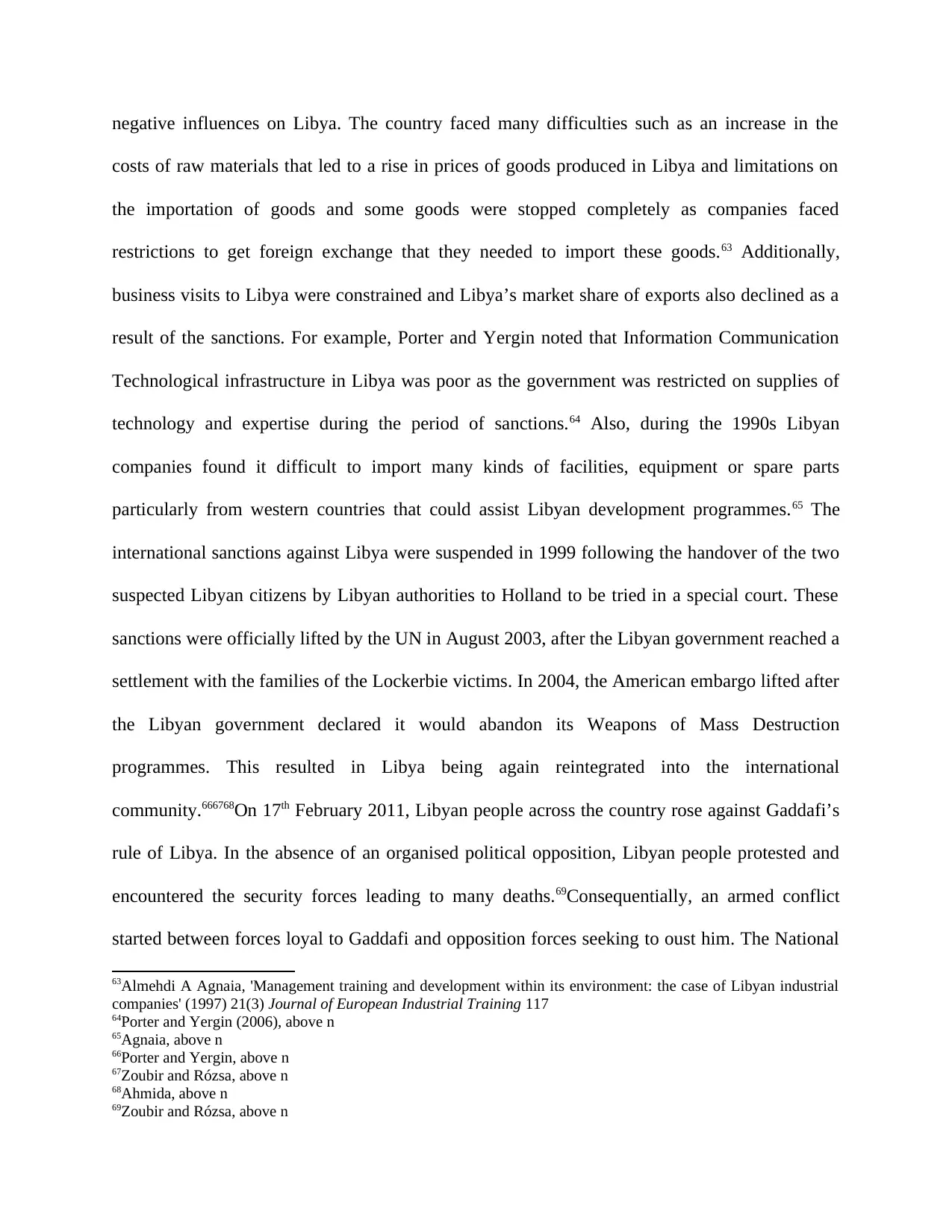
negative influences on Libya. The country faced many difficulties such as an increase in the
costs of raw materials that led to a rise in prices of goods produced in Libya and limitations on
the importation of goods and some goods were stopped completely as companies faced
restrictions to get foreign exchange that they needed to import these goods.63 Additionally,
business visits to Libya were constrained and Libya’s market share of exports also declined as a
result of the sanctions. For example, Porter and Yergin noted that Information Communication
Technological infrastructure in Libya was poor as the government was restricted on supplies of
technology and expertise during the period of sanctions.64 Also, during the 1990s Libyan
companies found it difficult to import many kinds of facilities, equipment or spare parts
particularly from western countries that could assist Libyan development programmes.65 The
international sanctions against Libya were suspended in 1999 following the handover of the two
suspected Libyan citizens by Libyan authorities to Holland to be tried in a special court. These
sanctions were officially lifted by the UN in August 2003, after the Libyan government reached a
settlement with the families of the Lockerbie victims. In 2004, the American embargo lifted after
the Libyan government declared it would abandon its Weapons of Mass Destruction
programmes. This resulted in Libya being again reintegrated into the international
community.666768On 17th February 2011, Libyan people across the country rose against Gaddafi’s
rule of Libya. In the absence of an organised political opposition, Libyan people protested and
encountered the security forces leading to many deaths.69Consequentially, an armed conflict
started between forces loyal to Gaddafi and opposition forces seeking to oust him. The National
63Almehdi A Agnaia, 'Management training and development within its environment: the case of Libyan industrial
companies' (1997) 21(3) Journal of European Industrial Training 117
64Porter and Yergin (2006), above n
65Agnaia, above n
66Porter and Yergin, above n
67Zoubir and Rózsa, above n
68Ahmida, above n
69Zoubir and Rózsa, above n
costs of raw materials that led to a rise in prices of goods produced in Libya and limitations on
the importation of goods and some goods were stopped completely as companies faced
restrictions to get foreign exchange that they needed to import these goods.63 Additionally,
business visits to Libya were constrained and Libya’s market share of exports also declined as a
result of the sanctions. For example, Porter and Yergin noted that Information Communication
Technological infrastructure in Libya was poor as the government was restricted on supplies of
technology and expertise during the period of sanctions.64 Also, during the 1990s Libyan
companies found it difficult to import many kinds of facilities, equipment or spare parts
particularly from western countries that could assist Libyan development programmes.65 The
international sanctions against Libya were suspended in 1999 following the handover of the two
suspected Libyan citizens by Libyan authorities to Holland to be tried in a special court. These
sanctions were officially lifted by the UN in August 2003, after the Libyan government reached a
settlement with the families of the Lockerbie victims. In 2004, the American embargo lifted after
the Libyan government declared it would abandon its Weapons of Mass Destruction
programmes. This resulted in Libya being again reintegrated into the international
community.666768On 17th February 2011, Libyan people across the country rose against Gaddafi’s
rule of Libya. In the absence of an organised political opposition, Libyan people protested and
encountered the security forces leading to many deaths.69Consequentially, an armed conflict
started between forces loyal to Gaddafi and opposition forces seeking to oust him. The National
63Almehdi A Agnaia, 'Management training and development within its environment: the case of Libyan industrial
companies' (1997) 21(3) Journal of European Industrial Training 117
64Porter and Yergin (2006), above n
65Agnaia, above n
66Porter and Yergin, above n
67Zoubir and Rózsa, above n
68Ahmida, above n
69Zoubir and Rózsa, above n
⊘ This is a preview!⊘
Do you want full access?
Subscribe today to unlock all pages.

Trusted by 1+ million students worldwide
1 out of 38
Your All-in-One AI-Powered Toolkit for Academic Success.
+13062052269
info@desklib.com
Available 24*7 on WhatsApp / Email
![[object Object]](/_next/static/media/star-bottom.7253800d.svg)
Unlock your academic potential
Copyright © 2020–2025 A2Z Services. All Rights Reserved. Developed and managed by ZUCOL.


